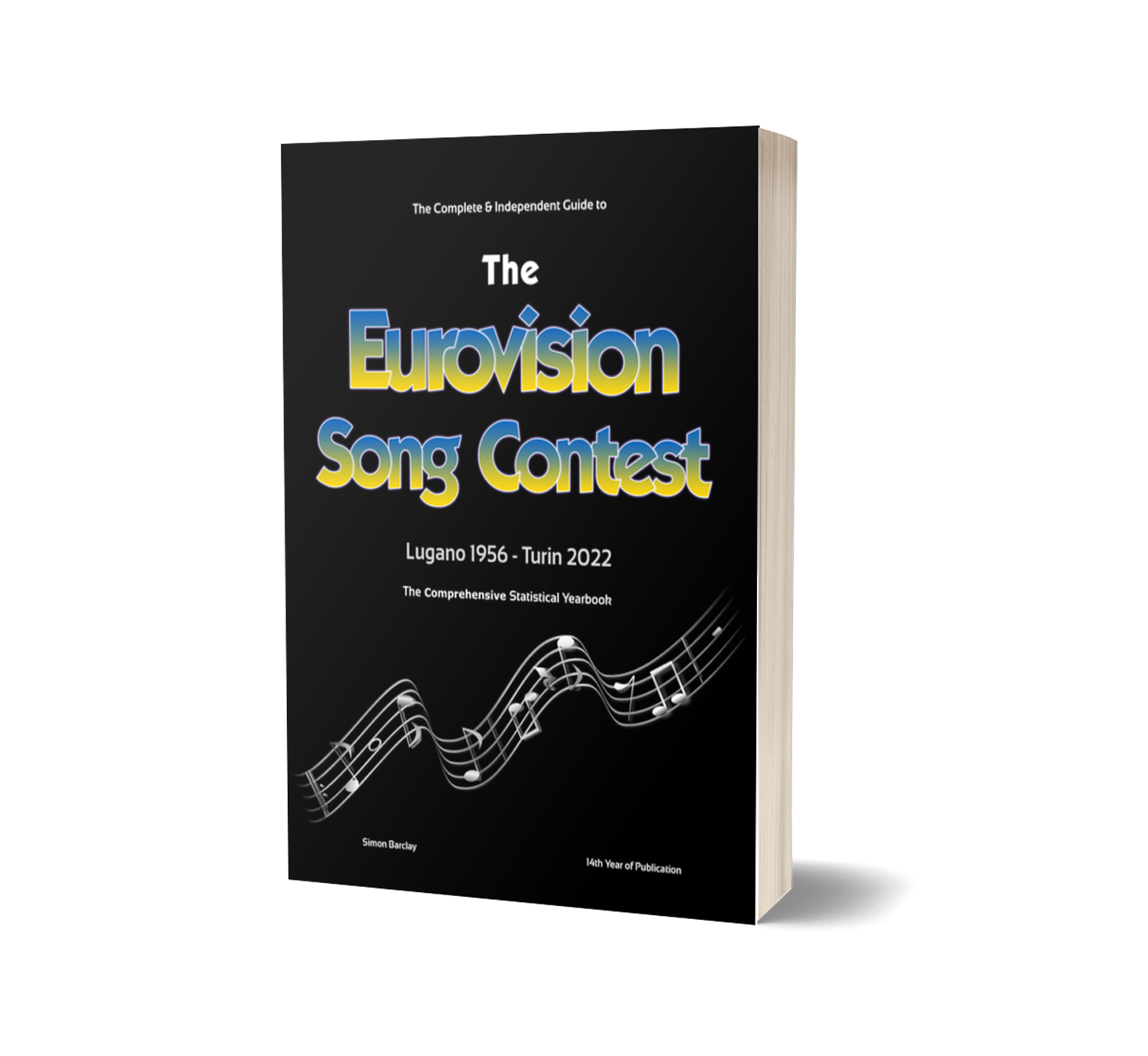Payments can be made securely by Paypal or by credit/debit card. The book will be dispatched in around 10-14 days, but please allow up to 28 days for delivery.
Note for EU customers: we pay the EU IOSS VAT so there will be no further charges when the book arrives.
|
|
|
Introduction to the 2022 Edition
Italy hosted the 66th Eurovision song Contest this year, following Måneskin’s win with “Zitti e buoni”. It was staged at the PalaOlimpico in front of a capacity 13,000 audience, and it was good to see a full arena for the first time since 2019 following the Covid restricted audience size last year in Rotterdam. This was Italy’s third time hosting the event, with Naples having hosted in 1965 and Rome in 1991.
Forty countries participated, one more than in 2020, as we welcomed back Montenegro and Armenia. Russia was excluded because of its further invasion of Ukraine earlier this year, although it had originally been cleared to participate by the EBU the decision was reversed following pressure from national broadcasters around Europe and subsequently the EBU announced that the inclusion of Russia could bring the Contest into disrepute. Belarus was already banned due to an earlier contravention of the EBU rules.
The level of public support for Ukraine’s participation on the other hand was overwhelming and led to a monster score in the public voting both in the semi-final and final. Kalush Orchestra received 439 points from the public in the final out of a possible 468 with 28 countries awarding their 12 points to them and their performance of “Stefania”. It’s all the more remarkable given that Kalush Orchestra only finished second in their qualifying competition and took the place of the original winner who had been disqualified.
This was Ukraine’s third win, Kalush Orchestra repeating the achievement of Ruslana in 2004 and Jamala in 2016. At the time of writing, it has not been decided whether Ukraine will host next year’s Contest, but there is every hope it will be possible.
The “Big 5”’s performance was again polarised this year but in a surprisingly different way. Perennial poor performers United Kingdom and Spain produced their best results in decades to finish second and third respectively and to see the UK winning after the jury points was quite special! Less impressively, Germany finished last, the latest in a run of wretched results. Italy finished in sixth place, the best performance by a host country since 2016.
There was controversy this year which came to light during the announcement of the jury results in the final. There were “technical difficulties” when it came to Azerbaijan, Romania and Georgia and the EBU’s supervisor Martin Österdahl had to give these countries’ jury points, although it was announced later that the jury votes of six countries, these three plus those for San Marino, Georgia and Montenegro were nullified as “suspicious” and replaced by estimated points based on similar countries. We have tried to adjust this year’s analysis to take this into account. But readers of our book will not have been surprised by the EBU’s actions, we highlighted last year the strange jury voting pattern between Poland and San Marino for example. Questions remain over the credibility of some countries’ juries – how could Azerbaijan qualify for the final after receiving zero points in the public vote? Spain’s jury gave 12 points to Azerbaijan in both the semi-final and final, yet the Spanish public gave zero both times. The breakdown of the individual Spanish jurors shows four of the five jurors placed Azerbaijan as the best song in the semi-final and final, and when we see examples like this, investigation and intervention by the EBU should be encouraged to protect the integrity of the Contest.
Contents
Eurovision Winners since 1956
Section One: Qualifying for the 2022 Contest
Section Two: Contest Details & Votes
Contest performers and voting tables: 1950's
Contest performers and voting tables: 1960's
Contest performers and voting tables: 1970's
Contest performers and voting tables: 1980's
Contest performers and voting tables: 1990's
Contest performers and voting tables: 2000's
Contest performers and voting tables : 2010's
Contest performers and voting tables : 2020's
2022 First Semi-Final performers, jury voting, televoting and combined results
2022 Second Semi-Final performers, jury voting, televoting and combined results
2022 Final performers, jury voting, televoting and combined results
2022 Final: Voting Order & Spokespersons
Round by Round voting & changes to scoreboard: Jury Voting
Round by Round voting & changes to scoreboard: Public Televoting & combined results
Previous voting sytem: First Semi-Final results
Previous voting sytem: Second Semi-Final results
Previous voting sytem: Final results
Country-by-Country History
Section Three: Statistics & Analysis
Predicting the Winners, the history of votes for the best song
Predicting the Winners, who gives the most 12's and who gives nothing
Marcel Bezençon Awards
OGAE poll result
Internal selection or national competition
Winners' Ages & Genders since 1956
2019 Contestants profile - singers & backing performers
Language history by country
Most Successful Countries League Table
Least Successful Countries League Table
Most Finishes in Top 3
Most Finishes in Bottom 3
Best & worst at qualifying from the semi-finals
Best semi-final to compete in
Most consecutive semi-final failures
Unluckiest semi-finals for each country
Performance of the "Big 5"
Running Order analysis, where is best to perform? Previous voting system
Running Order analysis, where is best to perform? New voting System
Winners & losers position in the order of performance since 1975
Double Douze!
Are You Sure? When Juries and the Public Disagree
Highest number of 12's received by one country
Lowest number of 12's received by a winning country
12 Points Go To… a 10 year history by country
History of 12 points from juries and public since 2016
Sharing The Love: the concentration of points awarded
The host country's performance since 1975
Nil Points!
Highest scores in finals
Largest and smallest winning margins
Performance of debutant countries since 1956
League Table of Appearances
Closest voting relationships
Each Country's Best Friends & their 10 year voting history
The most one-sided voting - who doesn't reciprocate?
And countries who have never voted for another
The least friendly pairs of countries: all results since 1975
The least friendly pairs of countries: the effect of the public vote from 2016 onwards
Jury/Public split of points in finals since 2016
Most Points Received since 1975
East v West - the impact of geographical voting
Bloc voting by juries and the public in the 2022 Final
Complete country-by-country voting analysis since 1975 - who votes for who?



No comments:
Post a Comment